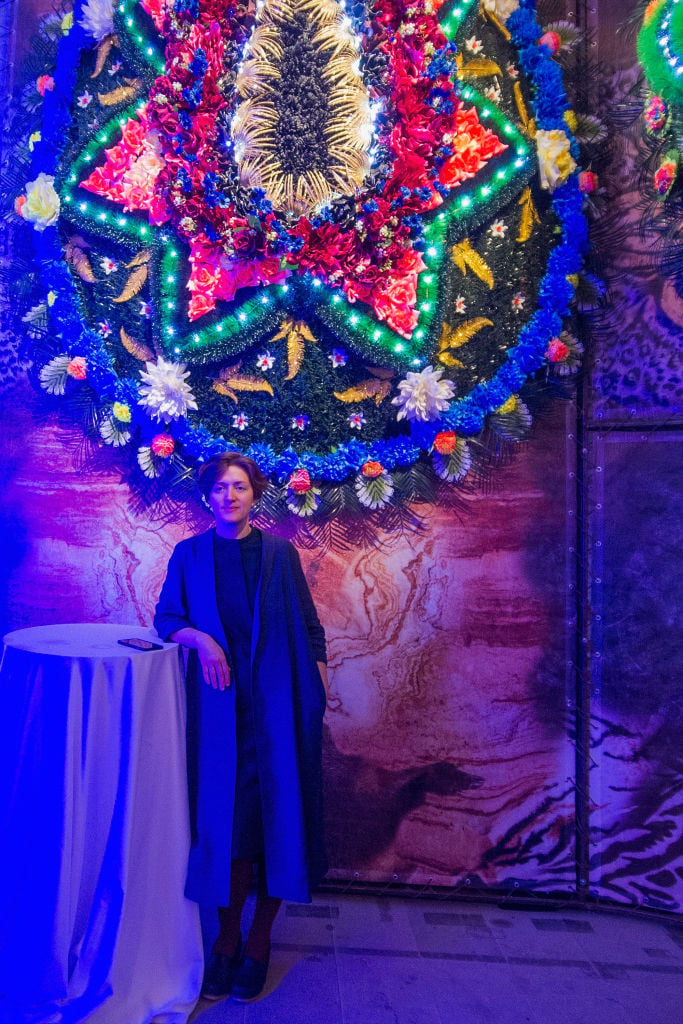
Three Russian artists were hand-picked by Christine Macel for the 57th Venice Biennale: Taus Makhacheva, Irina Korina, and Vadim Fishkin. The French curator invited 120 artists to present their signature works at one of the world’s most anticipated art events, and her choice of Russian artists is one of an experienced connoisseur. Below, we introduce you to these rising stars: three of the more fearless comrades coming out of Russia’s contemporary art scene.
Taus Makhacheva, Tightrope, video still. 4K Video, 73min, color, sound, 2015. Courtesy of the artist.
1. Taus Makhacheva (b. 1983 in Moscow.)
Dagestani artist Taus Makhacheva is presenting two seemingly different works at the Biennale’s exhibition, “Viva Arte Viva.” The video work Tightrope (2015), presented at the main pavilion in the Giardini, was discovered by Christine Macel at the “But Still Tomorrow Builds into My Face” exhibition, curated by Nat Muller, during Art Dubai fair in 2016. The piece is about the basic doubts an artist might have in making their own work, and the difficulty of trying to balance real-life responsibilities with an artistic practice.
At about the same time, Macel saw a performance by the artist’s alter ego, Super Taus, at the Centre Pompidou in Paris. As part of the “Museum On/Off” exhibition curated by Alicia Knock, the artist carried a large statue of two women on her back through the museum. A little later, they met in person and decided to create a completely new performance for the Venice Biennale that was going to be outside the audience’s field of vision.
Taus wanted to express her frustrations about how exceptionally tired she was of the precarity of the art world. “The fact that the artists are barely surviving, have to fight for their works, but happen to be the last persons to be paid is unacceptable,” Taus told artnet News. The performance, called Baida (Russian name for boats), is about the invisibility of the artist as worker.
The only physical thing you can find at the Giardini della Vergine is a label saying that there is a performance happening at certain coordinates in the Adriatic sea, where you can find several performers in a capsized boat. If you rent a boat, you may be able to find it and see it in person. More conveniently, however, the artist notes that the performance will also be streamed on the Biennale’s website.
Makhacheva’s works often start from a story told, encountered, imagined, witnessed, or read. She went to the Starii Terek village in Dagestan where a lot of fishermen live. She had many conversations that served as the basis for the performance there: “The story of Shamil Fiksa [one of the fishermen] struck me, how he survived for nine days in the storm in a capsized boat. [My piece] is about these missing bodies, absent, imaginary bodies, performances in liminal spaces—that’s what ‘Viva Arte Viva’ is for me. It happens maybe somewhere in your imagination, maybe somewhere online.”
View inside Irina Korina’s environment Good Intentions, (2017). Photo by Ben Davis.
2. Irina Korina (b. 1977 in Moscow.)
Irina Korina’s site-specific installation Good Intentions might take some effort to find in the dark halls of the Arsenale. It was developed together with Macel, who has been following Irina’s work for quite some time. The massive two-story building surrounded by Kremlin-like brick columns, and camouflaged in construction site materials, contains the symbolism of Russia’s new military ideology.
The work was produced in Moscow, in part with funding from the Garage Museum of Contemporary Art; it arrived to Venice in several pieces and was assembled on site. The artist told artnet News that the logistics of delivering these massive parts to Venice became a real challenge for her team, as the artist is responsible for every aspect of the installation, including paying for customs.
“My work reflects the immediate environment around me today in Moscow,” Korina said. “I stage the direct reference to this deceptive traditional world that is supposed to be something promising, kind and soothing, as if it contains some kind of answers and hope for the Russian people. These are merely masks and costumes that create our governmental aesthetics covering up something frightening. The new cult of death is being reborn together with the rising tendency of patriotism and new ideas of border control. This new state deeply disturbs and saddens me. It is a fictitious reality that people are happy to self-delude themselves with.”
You can also find a second project by Korina at the newly-opened V-A-C Foundation Space in Venice.
Vadim Fiškin, Doorway, 2015. Photo by Ben Davis.
3. Vadim Fiškin (b. 1965 in Penza.)
Vadim Fiškin, who is presently based in Ljubljana after being invited there by the informal organization Neue Slovenische Kunst (NSK), was once referred to as “the most Russian among Westerners and the most Western among Russians.” Macel was familiar with his previous work presented at Manifesta 10 in St. Petersburg, and at the Galerija Gregor Podnar in Berlin. After meeting the artist in person, she knew that she wanted to include his work in the “Time and Infinity” Pavilion. His digital project, Doorway (2015), can be found in one of the far corners of the Giardini della Vergine. A door, which constantly opens and closes, is projected onto a brick wall. When the door opens, a promising bright light comes into view beyond it.
To describe his work, Fiškin likes to quote René Daumal, the French writer and cult figure of the ’70s: “The door into invisible must be visible.” What matters to the artist is not the esoteric but the cognitive—a kind of utopian vision that attempts to seize the unknown.